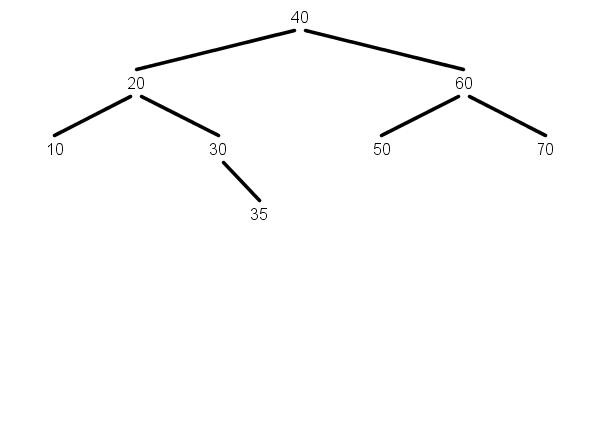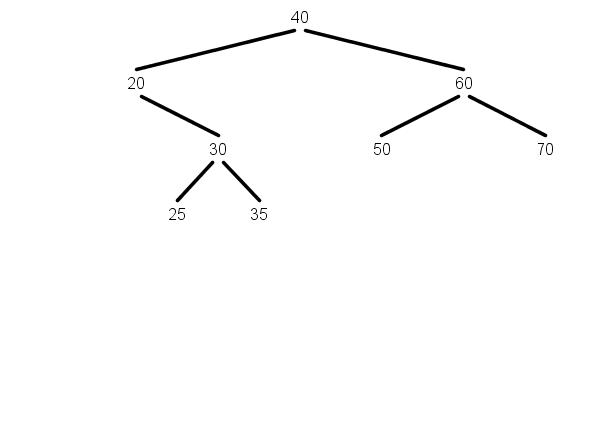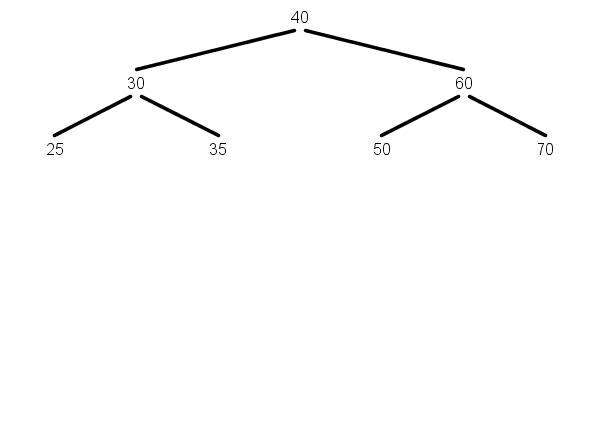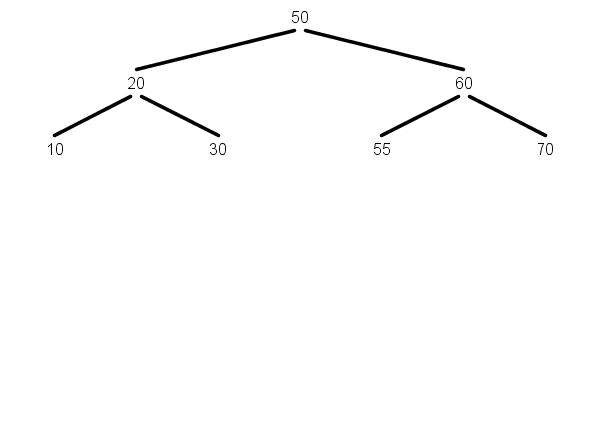The BinarySearchST implementation uses a sorted array of keys which has the advantage of making
searches fast - order log(N).
The disadvantage of this array implementation is with insertions.
A binary search tree implementation uses linked nodes, but
attempts to retain the advantages of the array implementation
while overcoming the disadvantage.
A binary search tree imitates the fast searching possible using
binary search in an array by beginning at the root whose key is a
value in the "middle".
At the same time, insertion in a binary search tree avoids the disadvantage of
having to move other keys as in the array implementation.
A binary search tree implementation of the symbol table type
can be more efficient than the array implementation class
BinarySearchST.
The value associated with a key plays no role in the
implementation of the put, get and delete symbol table
methods.
If we omit the value and just keep the key, a symbol table
reduces to a collection of distinct keys. But the implementation
of the put, get, and delete methods will be the same.
We will examine a binary search tree implementation of such a
class, BSTSet, which stores keys only and to simplify things a bit
more, we will use only integer keys.
To implement BSTSet as a binary search tree
the following private Node inner class will be used:
private class Node
{
private int key;
private Node left;
private Node right;
private Node(int k)
{
key = k;
left = null;
right = null;
}
}
The simple BSTSet will get by with a single data member, the
root:
public class BSTSet
{
private Node root;
public BSTSet()
{
root = null;
}
...
}
If a problem of size N can be broken into subproblems, a
method to solve the problem can be implemented by writing and
calling methods for each of the subproblems.
If the subproblems are the same as the original problem, but
just of smaller size M, then instead of writing different methods
for the subproblems, the same
method can be use. That is, the method for the original problem
can call itself to solve the subproblems. That is, the method can
be recursive.
The "problems" for the BSTSet are put, get, and
delete. Can these methods be recursive? Why should they
be?
The reason they can be recursive is because of the
recursive nature of the binary tree itself:
A binary search tree is either:
- empty, or
- a left subtree, a root, a right subtree
For example, to put a key into a non-empty tree,
reduces to a subproblem: put the key into the appropriate
subtree. So the subproblem is the same as the original
problem. Put a key an a binary search tree.
There is a problem with making put recursive. The subtrees, like the whole tree is referenced by
the Node at its root. But Node is private in the BSTSet as usual
in order to keep a clean separation between the symbol table
operations and the implementation.
The solution is to use two methods, one public that doesn't
expose the Node type, but which calls a private helper.
The helper method can have Node as a parameter and/or return
type since it is private. So it is the helper method that can be
recursive.
This approach is often required for other Java classes whenever
a recursive method is a natural way to implement a member method.
The size method illustrates the technique.
The size of the tree can be split into subproblems of the same
kind:
size of tree = size of left subtree + size of right subtree + 1 (for the root)
Java
allows methods to be overloaded,
which means that methods in the same class can have the same name. However, they
must have different parameter lists. That allows the compiler to
know which one is called.
In particular, the public and its private recursive helper can
have the same name.
The public size method simply invokes the private, recursive
method.
The private recursive size method follows the outline of
breaking it into the subproblems of getting the size of the subtrees.
public int size()
{
return size(root);
}
private int size(Node t)
{
if (t == null) {
return 0;
}
return size(t.left) + size(t.right) + 1;
}
A public method for drawing the BSTSet trees will be
provided. Although it isn't necessary for applications, it may be
useful for debugging.
For example,
BSTSet s = BSTSet.fromString("40 60 70 50 20 10 30 35");
s.drawTree();
StdDraw.show();

The put method is a slightly different pattern since it changes
the tree while the size method does not. This means that put must
change some links.
However, put uses the same approach of using a public method
and a private, recursive helper method.
The recursive solution the "problem" of putting x into the
whole tree reduces to putting x into the appropriate subtree:
if x < root.key, put x in the left subtree
else if x > root.key, put x in the right subtree
The difference between the recursive implementation of
size and that of put, is that the private
recursive method needs to return a reference to the modified
subtree. This return Node is needed since new keys are inserted
where a null link was. This null link needs to be reset to
reference the Node returned by the recursive call.
The implementation:
public void put(int x)
{
root = put(root, x);
}
private Node put(Node t, int x)
{
if (t == null) {
return new Node(x);
}
if (x < t.key) {
t.left = put(t.left, x);
} else if (x > t.key) {
t.right = put(t.right, x);
}
return t;
}
The recursive description of the get method to search
for x:
if x < root.key search for x in the left subtree
else if x > root.key search for x in the right subtree
else x is found at the root.
The delete method follows the public/private recursive general
pattern, but as is sometimes the case with data structure classes,
the delete method seems to present some additional
difficulties.
The delete method for BSTSet is no exception. There are two
cases:
Deletion is easy. In this case the node to be deleted is the
root of a subtree, but one link (left or right) is null. Just
"promote" the other child to be the new root of the subtree.
The Node with key = 20 below has only one child, 30. To
delete 20, "promote" the subtree at 30 to take 20's place as the
child of 40.

After deleting 20, the subtree at 30 "moves up":

The method to delete a key k can be described
easily and is similar to the put method in that we must first find the node
containing k (if there is one):
To delete k from the tree:
- if k < the key in the root of this tree, delete k
(recursively) from the left subtree and reattach the modified left
subtree.
- else if k > the key in the root of this tree, delete k
from the right subtree and reattach the modified right
subtree.
- else k is equal to the key in the
root of the tree. If so, delete this node and return the
possibly new root of the modified tree.
This guides us to write the same sort of pair public/private
methods for delete as for put, but must fill in the part to delete
the Node containing k once we have found it.
We haven't handled the bad case 2 yet, but let's see what the
code would be just to handle the search AND case 1.
Begin with the usual public/private pair of methods,
remembering that deletion modifies the tree (like put, but unlike
size()). In particular the root might change.
public void delete(int k)
{
root = delete(root, k);
}
public Node delete(Node t, int k)
{
if (t == null) {
return null; // k not in the tree
}
// Find the node to delete: the one containing k
if (k < t.key) {
t.left = delete(t.left, k);
} else if (k > t.key) {
t.right = delete(t.right, k);
} else { // we found it. Now delete t
if (t.left == null) { // So we are in case 1
return t.right;
} else if (t.right == null) { // Also in case 1
return t.left;
} else {
// THE BAD CASE 2 - t has two children
}
}
return t;
}
If the node to be deleted has 2 children there are 2 obvious
candidates to replace the key at that node:
- the next larger key
- the previous smaller key
Once this choice is made, we must decide how to change the tree
to accomplish this replacement.
The following choices describe the deletion and is called
Hibbard deletion.
- Choose the next larger key as the replacement
- Replace the key to be deleted with this next larger key.
- Delete the replacement key from the subtree where it was located.
Delete 40 from this tree. The next larger key is 50.
Replace key 40 with 50.
Now 50 is in two nodes. Delete 50 from the right subtree. Note
that it in the right subtree 50 will not have a left child, so
deleting it is handled by the simpler case 1 part of the code.
Set 50's left and right links to be 40's left child and the
modified right child (50 was deleted from the right child).


public void delete(int k)
{
root = delete(root, k);
}
public Node delete(Node t, int k)
{
if (t == null) {
return null; // k not in the tree
}
// Find the node to delete: the one containing k
if (k < t.key) {
t.left = delete(t.left, k);
} else if (k > t.key) {
t.right = delete(t.right, k);
} else { // we found it. Now delete t
if (t.left == null) { // So we are in case 1
return t.right;
} else if (t.right == null) { // Also in case 1
return t.left;
} else {
// THE BAD CASE 2 - t has two children
Node s = min(t.right);
t.key = s.key;
t.right = delete(t.right, t.key);
}
}
return t;
}
How would we write min and max?
These follow the pattern of size, and can also be written as
the same public/private pair and use recursion.
The binary search tree requires that the keys be ordered. The
basic types (int, double, char, ...) have a natural ordering and
we use the relational operators <, >, etc.
Class types used as keys must implement the compareTo
method, such as String.
So the binary search tree implementations of symbol table (and
set) should implement the additional methods for ordered symbol
tables:
- min
- max
- floor
- ceiling
- rank
- select
Implementing min and max is easy with the usual approach. What
about the others?
This assignment is to add a number of methods to the BSTSet
class to give you practice using recursion. The methods will all
use the technique of the public/private pair of methods with the
private method being the recursive one.
Group I
-
size (provided for you)
-
height
-
sizeOdd - number of Nodes with an odd key
-
isPerfectlyBalancedS - at each Node, do left and right
subtrees have same size?
-
isPerfectlyBalancedH - at each Node, do left and right
subtrees have same height?
-
isOddBalanced - at each Node, do left and right subtrees
contain the same number of odd keys?
-
isSemiBalancedI - is each Node semibalanced? leaf or else
size(larger child) / size (smaller child) <= 2
-
sizeAtDepth - number of nodes at a given depth
-
sizeAboveDepth - number of nodes whose depth is < a
given depth
-
sizeBelowDepth - number of nodes whose depth is > a
given depth
Group II
-
removeOddSubtrees
-
removeLeaves
-
removeSingles
-
removeDepth
-
addZeroToSingles
-
sizeAtHeight
-
sizeAboveHeight
-
sizeBelowHeight
-
removeHeight




